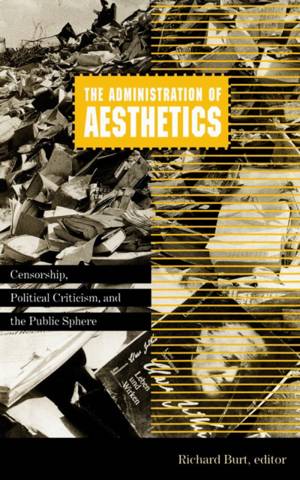
- Afhalen na 1 uur in een winkel met voorraad
- Gratis thuislevering in België vanaf € 30
- Ruim aanbod met 7 miljoen producten
- Afhalen na 1 uur in een winkel met voorraad
- Gratis thuislevering in België vanaf € 30
- Ruim aanbod met 7 miljoen producten
Zoeken
Administration of Aesthetics
Censorship, Political Criticism, and the Public Sphere Volume 7
Richard Burt
€ 30,95
+ 61 punten
Omschrijving
Calls attention to the crucial difficulties inherent in censorship when it is used as a tool for cultural criticism.
The "new" censorship of the arts, some cultural critics say, is just one more item on the "new" Right's agenda, and is part and parcel of attempts to regulate sexuality, curtail female reproductive rights, deny civil rights to gays and lesbians, and privatize public institutions. Although they do not contest this assessment, the writers gathered here expose crucial difficulties in using censorship, old and new, as a tool for cultural criticism.
Focusing on historical moments ranging from early modern Europe to the postmodern United States, and covering a variety of media from books and paintings to film and photography, their essays seek a deeper understanding of what "censorship," "criticism," and the "public sphere" really mean.Getting rid of the censor, the contributors suggest, does not eliminate the problem of censorship. In varied but complementary ways, they view censorship as something more than a negative, unified institutional practice used to repress certain discourses. Instead, the authors contend that censorship actually legitimates discourses-not only by allowing them to circulate but by staging their circulation as performances through which "good" and "bad" discourses are differentiated and opposed.These essays move discussions of censorship out of the present discourse of diversity into what might be called a discourse of legitimation. In doing so, they open up the possibility of realignments between those who are disenchanted with both stereotypical right-wing criticisms of political critics and aesthetics and stereotypical left-wing defenses. Contributors: Richard Burt, Stuart Culver, Donald Hedrick, Christian Jouhaud, Michael G. Levine, Timothy Murray, Aamir Mufti, David Norbrook, Dennis Porter, Brook Thomas, Jirina Smejkalová-Strickland, Jeffrey Wallen, and Rob Wilson.Specificaties
Betrokkenen
- Auteur(s):
- Uitgeverij:
Inhoud
- Aantal bladzijden:
- 416
- Taal:
- Engels
- Reeks:
- Reeksnummer:
- nr. 7
Eigenschappen
- Productcode (EAN):
- 9780816623679
- Verschijningsdatum:
- 3/10/1994
- Uitvoering:
- Paperback
- Formaat:
- Trade paperback (VS)
- Afmetingen:
- 138 mm x 217 mm
- Gewicht:
- 453 g

Alleen bij Standaard Boekhandel
+ 61 punten op je klantenkaart van Standaard Boekhandel
Beoordelingen
We publiceren alleen reviews die voldoen aan de voorwaarden voor reviews. Bekijk onze voorwaarden voor reviews.












